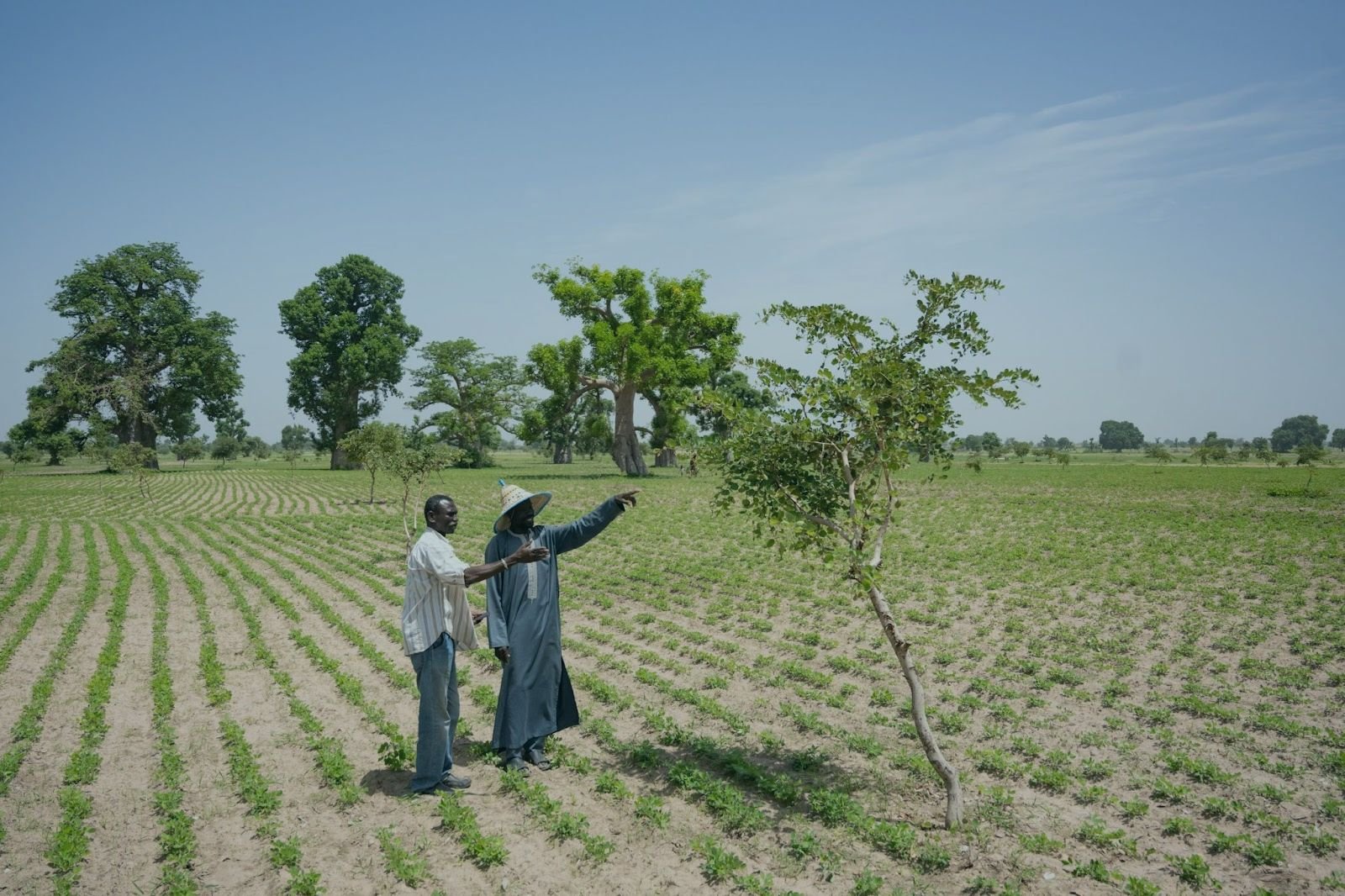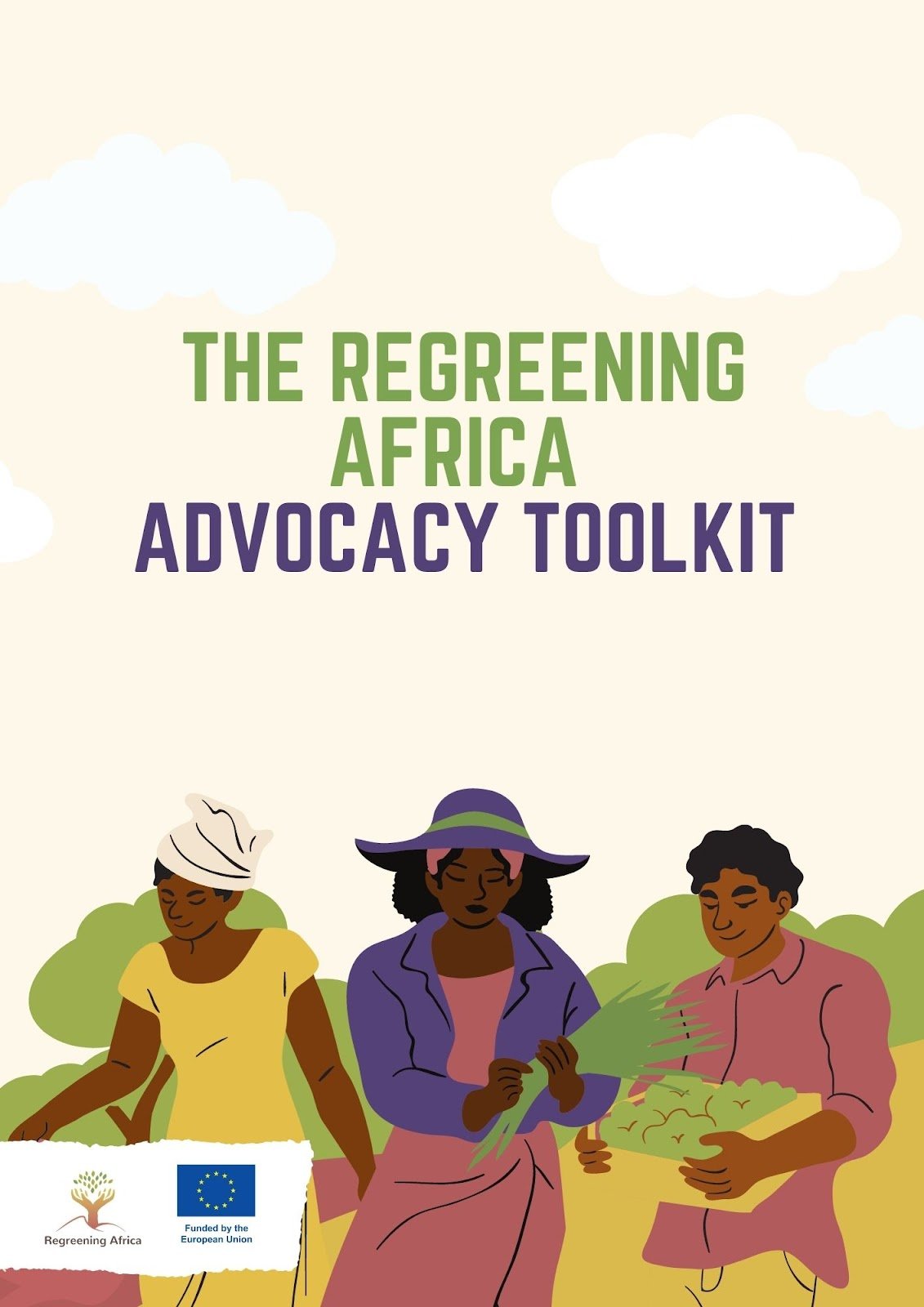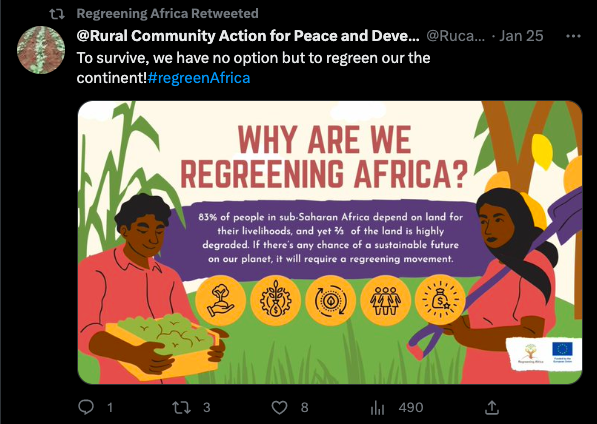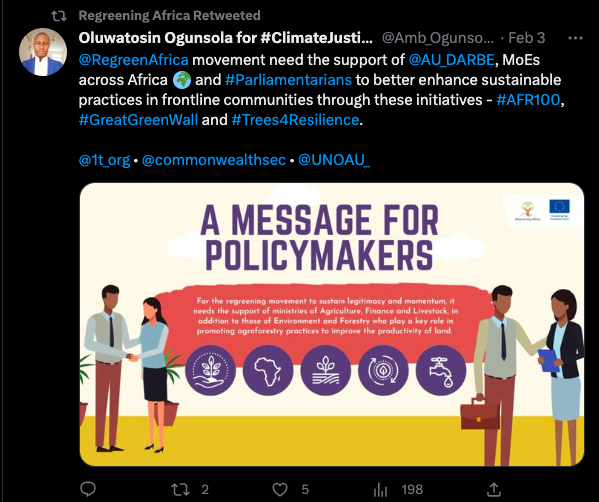Regreening Africa: Growing a Land Restoration Movement in Sub-Saharan Africa
Regreening Africa, backed by the EU, restores one million acres of degraded land in Sub-Saharan Africa, integrating trees to boost soil fertility and farmers' livelihoods.
Land is life. Fertile land and soil is the basis of healthy ecosystems, and productive farming and thriving local communities.
Regreening Africa, a large scale project backed by the European Union and implemented by the World Agroforestry Centre (ICRAF), aims to restore degraded land in Sub-Saharan Africa by integrating trees into land management across Kenya, Senegal, Rwanda, Ghana, Ethiopia, Mali, Niger, and Somalia.
The first phase of this epic project, which concluded in February 2023, aimed to restore 1 million acres of degraded land, while working with thousands of farmers to help them integrate trees that would enhance soil fertility, increase crop yields, and help sustain their livelihoods.
As the project concluded, Treeshake was tasked with telling their story, engaging their community of stakeholders, and helping lay the groundwork for continued application of the work through the local country partners.
Results
Contributing to the UN’s inspiring Great Green Wall initiative (https://www.unccd.int/our-work/ggwi) to restore 100 million hectares of currently degraded land; sequester 250 million tons of carbon and create 10 million green jobs by 2030.
What is Land Degradation
Degraded land refers to land that has lost its natural productivity due to human activities such as deforestation, overgrazing, intensive agriculture, and unsustainable land use practices. As a result, the land becomes less fertile, loses its ability to retain water, and is more susceptible to erosion, desertification, and other forms of land degradation. This can lead to reduced agricultural yields, food insecurity, and increased poverty for the people who rely on the land for their livelihoods.
Degraded land can also have negative environmental impacts, such as reduced biodiversity, increased greenhouse gas emissions, and decreased carbon sequestration. This can exacerbate the effects of climate change and further undermine the resilience of local communities and ecosystems.
Land Degradation in Southern Africa
Land degradation is a global issue affecting many regions, but sub-Saharan Africa is one of the most severely affected regions. The problem is particularly acute in this region due to a combination of factors, including high population growth rates, low agricultural productivity, limited access to modern technologies, and climate change impacts such as drought and desertification.
In addition, many countries in sub-Saharan Africa have experienced rapid deforestation, overgrazing, and other forms of unsustainable land use practices due to factors such as population pressure, poverty, and weak governance. This has exacerbated the problem of land degradation in the region.
While other regions of the world also face land degradation challenges, the severity and scale of the problem in sub-Saharan Africa make it one of the most affected regions. As such, efforts to address the issue in this region are critical to achieving global sustainable development goals.
Story
Excellent storytelling is imperative to an advocacy campaign’s success so the first step was setting the narrative. Science communication, however, is notoriously difficult and requires a high degree of accuracy. Additionally, Regreening Africa is a complex project, running in varying levels of specificity across 7 different countries using multiple languages. So, how did we distil these insights and turn them into a narrative that was compelling enough for people to talk and get excited about?
The Regreening Africa Journey, a social video showcasing the project’s objectives and targets, sets the project narrative by unpacking the 5ws and H of the project, and emphasising why land restoration is especially crucial. The video was produced using footage renowned photographer Kelvin Trautman had taken with the Regreening Africa communities in Rwanda, Senegal, Ghana and other participating countries. Commissioned by Treeshake to sharpen the quality of the project’s visual outputs, Kelvin shot beautiful imagery of the teams, farmers and community members at work, as well as the landscapes in various stages of restoration, which is now used across the project’s various platforms.
People
A second key component of advocacy is people. To turn Regreening Africa into a movement, we needed to increase the number of people speaking about the project. We needed to inspire and enable advocacy. We needed to broaden the take-up of the message and equip other organisations and stakeholders to speak about the wonderful work, the impact, and the lessons.
Relationships are a critical part of the landscape restoration process and the project owes much of its success to the involvement of local communities and partners in formulating restoration strategies and data collection and analysis. Knowing this, we kicked off our advocacy strategy by activating relationships with our stakeholders - strengthening those that already exist and being on the lookout for new alignments. We did this with stakeholder mapping exercises such as list-building, tagging our supporters and partners in our content and creating content around them —making them an even more active part of the regreening story and further creating a community around the project.
For example, Regreening Heroes is a showcase of 24 individuals and 8 organisations that Regreening Africa wanted to celebrate for their passionate contributions to restoring landscapes and improving the lives of communities across Sub-Saharan Africa. Compiled by Sandiso Matshikiza, the list highlights the women, farmers, youth, and partners who are instrumental to the effectiveness of regreening initiatives across the continent and deserve to be celebrated. #RegreeningHeroes has accrued over 73 000 impressions on Twitter to date, engaging the heroes featured and their networks, as well as our existing followers.
ACtion
At the heart of the advocacy strategy was the creation of an advocacy toolkit, a set of resources for people who want to help bring awareness to the issue of land degradation in sub-Saharan Africa. The toolkit highlights the role each of us can play in rehabilitating these landscapes and improving the quality of life for the communities that are dependent on them for their livelihoods. It is comprised of a collection of graphics and call-to-action messages about why we need a regreening movement, with messages directed at policymakers, development partners, faith communities, farmers, and other stakeholders. The toolkit is a ready-made social media campaign that users can just share on their profiles and other online platforms.
To activate the advocacy toolkit, we invited our partners and supporters to a series of Zoom meetings where we shared the toolkit with them and trained them on how to use it effectively. A specific timeframe for them to share the toolkit with their audiences was decided on, and follow ups made post the training, to ensure that everyone was clear on the plan and objective. On the day of activation, we reminded people to post from their platforms, as well as encouraging them to engage with other posts carrying the hashtag #RegreeningAfrica. Below are some examples of some of the posts shared by partners and community members.
The Regreening Africa Summit
To celebrate the culmination of five years of restoring landscapes and livelihoods and to share the impact achieved in those five years, Regreening Africa hosted the Regreening Africa Summit, a virtual event where Regreening Africa community members, farmers and project partners were joined by some notable names in the global impact space, like Acting Director of the European Commission Africa Hans Christian Stausboll, World Vision Australia’s Tony Rinaudo, Christophe Besacier from FAO and Susan Chomba from World Resources Institute.
The goal of the Summit was to unpack insights, lessons, and achievements from the programme, as well as the way forward for the project and landscape restoration on the continent in general. Through a social media and stakeholder outreach strategy, with beautiful graphics by Amy Staark, we managed to get over 1500 signups for the event, with just over 550 online attendees on the actual day of the Summit. Online, conversation around the Summit was buzzing too, with a Twitter reach of over 200 000 impressions and nearly 600 engagements in the two hours the event ran.
Regreening Africa is a model for other projects and initiatives that seek to promote sustainable development and improve people's lives, and an effective example of how, through agroecology and other relevant practices, scalable and replicable land restoration is possible. What an honour to work on this project!
Client:
Regreening Africa
In partnership with World Agroforestry and European Union
Treeshake Team
Strategy & Tech: Dave Duarte
Project Management: Sandiso Matshikiza
Content & Community: Mwabi Jere
PR: Aithne Molotsane
Resources:
Advocacy Toolkit: https://regreeningafrica.org/regreening-africa-advocacy-toolkit/
Regreening Africa video: https://youtu.be/1XUyv1PKibg
Regreening Heroes: https://regreeningafrica.org/regreening-heroes/
Recording of RA Summit: https://youtu.be/duMJ4SpaZ28
Advocating for youth in Africa’s peace and security agenda #WhatMakesYouthFeelSafe
Working with ISS Africa we activated young peace-builders in 20 African countries; and gained lifelong lessons on community, leadership and the importance of incorporating play in work.
Written by Sandiso Matshikiza, Graphics by Schalk van der Merwe
In March 2021, we came together with the Institute for Security Studies for what seemed like a simple and straightforward project on Youth, Peace and Security. Activist Aya Chebbi was approaching the end of her two year term as the African Union’s first Youth Envoy, so we wanted to reflect on her work and ask the question “What’s next for Africa’s Youth Peace and Security agenda?”
The conclusions that we reached during our reflection process revealed some startling insights:
42% of the world's youth will be African by 2030, yet little is being done to equip young leaders on the continent. The African Union, whose mandate is to cover Youth Peace and Security among its other agendas, seems detached from the needs of the youth on the ground. Constantly excluded from key decisions and represented by leadership who are much older, African youth do not feel safe and they do not feel heard.
So what did we do?
With these daunting facts, we saw an opportunity to crowdsource the perspectives of youth from all over Africa to understand: What makes youth feel safe? What makes youth feel unsafe? What made this campaign special was that we took a simple question of safety in one's community, easily answerable by a small child, and used it as a line of communication between African youth and AU leaders. By answering the question, African youth were directly influencing the next steps for the African Youth Peace and Security (YPS) agenda.
We kickstarted the campaign with a WhatsApp group to discuss the topic. Working with ISS lead researcher, Munei Kujeke, we convened over 130 young peace builders in more than 20 African countries.
Whilst the official platforms for the campaign were Twitter, Facebook and Instagram, it was on our WhatsApp group where the conversation unfolded organically. We worked with these young people to turn their statements into videos, which eventually spilled over onto other the other platforms. As the week progressed, there was an outpouring of videos from all over Africa, with youth bravely speaking out on issues such as the importance of good governance, the scourge of gender based violence and the need for inclusivity and opportunities across all youth groups.
“Hearing multiple perspectives, in different languages with different cultural backgrounds, united through a noble purpose, is a feeling that can only be described as spiritual.”
With an organic reach of over 548 000 people, the #WhatMakesYouthFeelSafe campaign clearly struck a chord. From the first sprouts of debate on the WhatsApp group, right up to the peak of the conversation during the round-up seminar - the conversation was rich, vulnerable and gave all those involved a genuine sense of belonging and importance. Accordingly, it came as no surprise when we learned that the campaign had caught the eyes of broadcasting channels such as eNCA and Big Daddy Liberty who invited lead researcher Muneinazvo Kujeke for interviews.
Behind the scenes: Key challenges and breakthroughs
Behind the scenes, the campaign did not come without its challenges. A major technical obstacle that we came across was the realisation that although the call to action had been for videos, not everyone involved in the campaign had access to bandwidth. So as the week progressed, we improvised and included posters and text messages as part of the conversation.
For the community manager and interaction designer on the account, this was a debut campaign which we playfully describe as a ‘baptism of fire’.
“My personal breakthrough was when engagement with the initial videos was very low and people were just not joining the conversation. I realised the value of my vulnerability and the need to honour my responsibility as African youth. So I grabbed a pen and board and I added my voice.”
Our team saw its defining moment, however, as we approached the campaign round-up seminar and Schalk surprised us with a short clip which showed all the faces of the youth who had participated in the campaign. This strategic move shifted the energy of the campaign and raised the commitment levels of the participants significantly- showing us that before issues are unpacked, the affected parties value being seen and acknowledged.
So, in a campaign that was meant to bring attention to Africa’s Youth Peace and Security agenda, we managed to reach youth across the continent and got them to raise their voices on critical issues which affect them and their ability to flourish.
For us, some of the key learnings were:
The importance of an authentic engaging conversation behind a public mobilization;
The importance of leading by example, and showing community members how to participate.
The importance of supporting and acknowledging participants so they feel heard. Whether by responding to them on social media, or featuring them in the content directly.
#WhatMakesYouthFeelSafe carries lifelong lessons on community, leadership and the importance of incorporating play in work.




















